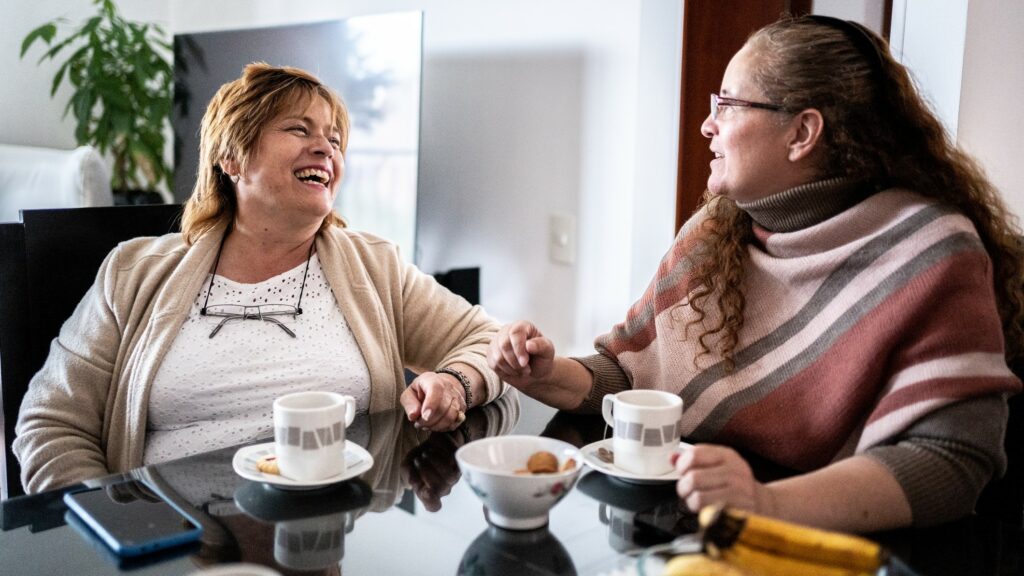Accepting that an aging family member’s health is declining can be a challenge. Talking with other family members about their new living options can be even harder.
In this article, Jacob Raptosh, Divisional Sales Director at Holiday, offers valuable insights into how to talk openly and effectively with family about senior living options for an aging adult.
6 steps to consider when talking to your family about an aging parent
- 1. Be objective
- 2. Do your research
- 3. Ask the older adult what they want
- 4. Plan the meeting
- 5. Communicate openly
- 6. Explore a backup plan

1. Be objective
“It’s critical for families to look objectively at what’s going on in the life of their aging family member,” said Raptosh. “That’s step one.”
Issues vary from senior to senior. From loneliness and failing to maintain their home to health problems caused or made worse by a poor diet, issues can develop in more than one area.
“We see our family members through eyes of love,” Raptosh said. “That can make it hard to see what’s really going on.
“I’ll often talk to families and they’ll say things like, ‘Mom is fine. She’s just a little forgetful.’ Then we’ll sit down together with the older person and we’ll notice something completely different, something a lot more concerning. Why? Because we’re seeing it objectively, together.”
Family discussions are typically initiated by the individual Raptosh calls the primary “influencer,” or the person who’s taken on the bulk of the responsibility for an aging family member. Over time, the burden has become overwhelming, prompting the influencer to seek a different option. Deciding what to do next usually involves the whole family.
Before reaching out to them, Raptosh says it’s helpful for the influencer to build a case. Family members who live far away aren’t likely to experience the day-to-day progression of decline and disregard the serious issues.
“Family who aren’t in regular contact will often say things like, ‘Well, you know she’s just getting older.’ Then we have to dig into the specifics of what that actually means,” he said.
Raptosh suggests that the influencer creates a detailed timeline of changes they’ve observed over the past six months. Is the house increasingly untidy? Is the mail stacking up? Has Mom or Dad lost a significant amount of weight?
Seeking input from neighbors, friends and doctors who regularly interact with the senior is also helpful. This allows the influencer to view things more objectively and present that reality to the family. Even asking a spouse for their perspective adds value.
As Raptosh points out, “The in-laws see things very differently.”
2. Do your research
“There are no tire kickers in senior living. People come to us for a reason.”
Having talked with countless families over the years, Raptosh admits misconceptions about senior living persist. He says families often struggle to understand all the options available for their aging parent. They often assume senior living is too expensive or is the same thing as a nursing home, which can have a lot of negative connotations.
By calling and visiting senior independent living communities, the influencer learns about the services and amenities their family member can enjoy. After learning about all the benefits, the influence can educate their family about senior living options and have a more productive discussion.

3. Ask the older adult what they want
Before having a family conversation, the influencer should reflect on previous experiences with their older family member. How have they responded to major life events? What takeaways from those experiences can be used to make the current situation easier?
Gently bringing up the idea of a future conversation can help prevent the older family member from experiencing defensive feelings. The influencer can set the stage by asking them how they feel about a possible change, and make it clear they’d like to talk about the older person’s future with the rest of the family.
While alone together, the influencer should ask what the older person actually wants, delicately, but directly. The senior deserves to be included in any decision that affects their life; the influencer needs to reassure the older adult they want what’s best for them.
The influencer needs to manage their expectations and be realistic. The aging parent may be saddened or resistant to the idea of moving. On the other hand, they might even be more open to the idea than the influencer thought.
Let the older adult’s response help guide the next steps. Keep in mind that there may need to be more than one conversation.

4. Plan the meeting
The influencer should schedule a face-to-face family meeting when and where it’s convenient for all. The best times may be around the holidays or other occasions when everyone typically comes together. If possible, the influencer should arrange for everyone to meet someplace near the older adult’s home so they can visit and observe things for themselves. The influencer can encourage family members to spend a day with the older person and share their experiences.
If family members live far away or arranging a time and place that works for everyone isn’t possible, consider setting up an online call together through Zoom, Skype or FaceTime.
5. Communicate openly
The influencer is most likely the discussion organizer. He or she should lead by example and communicate honestly and respectfully. Sticking to the facts can be helpful, and having talking points on hand will keep the discussion on track. The initial part of the conversation should focus on building support around the health, happiness and safety of the senior.
The point of this conversation isn’t to force anyone into a decision; it’s to explore possibilities together, so your older family member feels confident moving forward. Remind everyone of this goal at the start of the conversation.
Keep in mind that this may be the first of many meetings to come. Constant, open communication is key in Raptosh’s experience.
“Talking about your parent’s well-being can be challenging. But with a little bit of planning, patience and love, that challenge can be overcome.”

6. Explore a backup plan
Raptosh says the influencer can begin the conversation with family by setting boundaries. He or she can present the situation, describe the responsibilities they have taken on and ask others to help out – or work together to find an entirely different course of action.
The influencer must be direct and make it clear they cannot continue under the current circumstances. They may be stretched so thin they’ve neglected their own physical health, mental health or job responsibilities.
“The influencer is overwhelmed,” said Raptosh. “It’s unsustainable. The family needs to agree that the aging person can no longer stay in their home alone safely and the influencer can no longer manage it all alone. So what’s the backup plan?”
The influencer should be prepared with a list of tasks to either delegate or hand over to an outside party like a personal care provider or housekeeping service. If a family member lives in a different time zone, they won’t be available for hands-on tasks, but they could provide relief by paying someone to help instead.
A move to an independent senior living community is another option.
“For adult children, there can be a lot of guilt associated with even having this conversation,” said Raptosh. “They think, ‘I should be able to take care of my family member,’ or ‘I promised Mom we would never move Dad into a senior living community.’”
If the family is resistant to consider senior living, the influencer can suggest the parent moving in with another family member or a family member move into the parent’s home. This is what Raptosh calls the backup strategy. It serves as a wake-up call.
“I’ve said this to so many families before: ‘This story will end in one of two ways… either they move to a more supportive environment that’s built for it, or we try it with another family member, full-time. We can’t just leave them alone at home in an unsustainable environment.’
“I hear this all the time; ‘No one can take care of Mom as well as I can,’” said Raptosh. “And I say, ‘That may be true, but you go to your mom’s house once a day for an hour. The other 23 hours of the day, she’s alone.’
“As you look around our communities and see people engaging with one another, and you see people building friendships, and you see people having these new life experiences, playing games – you understand your mother has no access to any of that.
“Just remember, the main goal is finding a solution that works best for the older adult in your family’s life. Independent senior living could be that solution,” Raptosh said.
If your family is considering senior living for an aging family member, we can help. Find a Holiday by Atria community near you and schedule a visit today.
You might also like
Want to learn more about life at Holiday?
